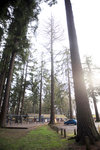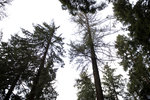

The city of Centralia announced Friday it would close the Fort Borst Park playground as of this afternoon, citing concerns from an arborist regarding the stability of two ailing Douglas firs and forecasted stormy weather for the weekend.
“The area will be taped off for public safety,” city attorney Shannon Murphy-Olson wrote in an email. “The city is in the process of contacting a tree removal company to make arrangements for topping of the tree(s) of concern.”
Certified arborist Ray Gleason, of Cascade Tree Experts, spoke in the public comment portion of Tuesday’s Centralia City Council meeting expressing grave concern for the safety of children at the playground, along with frustration at a perceived lack of interest in the problem on the part of city staff.
“I’m extremely concerned and I hope that everyone is,” he said Tuesday. “There’s probably greater than 50 branches directly on top of that swing set … I cannot believe this has been allowed.”
He asked the council on Tuesday to close the play area of the park.
“We’ll get back to you on that,” Mayor Lee Coumbs said.
Gleason, who grew up as part of a logging family in Randle, has been a certified arborist for 15 years. In November, he planted a sapling taken from a historic butternut tree planted by area pioneer George Bush at Fort Borst Park.
He’s worked in the logging industry, competed professionally in timber sports and completed four associate’s degrees and a bachelor’s degree in forest science-related fields, saying he is most educated on the topic of root systems.
“Like Rain Man was about math, I am about trees,” he said.
Often when traveling to East Lewis County to visit family, Gleason stops by Fort Borst Park to take a look at the trees. What he sees has been increasingly worrisome, he said.
“They have physiologically failed,” he said.
In layman’s terms, the trees are no longer processing nutrients, causing the branches to lose needles. A healthy tree’s branches can flex, but in a failing tree, branches become brittle and prone to unpredictable breakage, he said.
In his industry, evergreen trees are believed to have physiologically failed when they’ve lost 50 percent of their needles.
Gleason said several trees are in poor condition, but he pointed out two Douglas firs in particular in the area of the park’s playground that have lost an estimated 90 percent of their needles.
However, he said the trees’ ages and sizes mean the Douglas firs’ root systems have become intertwined and interdependent. Two very sick trees could indicate problems in the rest of the park. He said that interdependence has likely kept the two trees he identified standing as long as they have.
Soil compaction due to paving and use of the park has likely contributed to root damage that Gleason believes has led to the trees’ current state.
He said healthy trees also sometimes lose branches, but that isn’t as much of a concern as the dying trees. As an explanation, he likened it to getting a flat tire — If there’s nothing wrong with a tire, there’s still a chance it will go flat, he said, like a branch falling from a healthy tree. But if there’s a nail in your tire, you know sooner or later it will go flat.
It’s only a matter of time until branches fall from the sick trees, he said, and their proximity to the playground makes that a serious risk.
In addition to concerns about safety of children and families at the playground, Gleason said he believes the state of the trees leaves the city open to a lawsuit if anything should happen.
“I’m getting no money for this,” he said. “I have a thing called ethics.”
Concerns about the health of trees at Fort Borst Park first came up more than two years ago.
In June 2015, the city removed 13 of 27 trees identified in a study by the Washington Forestry Consultants, Inc. as posing a danger of injuring people or damaging property.
The remaining trees were planned to be taken down later.
The study, completed in February 2015, identified a mix of Douglas firs, Oregon white oak, Oregon white ash, cottonwood and broadleaf maple as problem trees.
They were all listed as a moderate to high risk to fall, according to previous Chronicle reporting on the study.
At the time, city staff said the number of trees identified in the report came as a surprise.